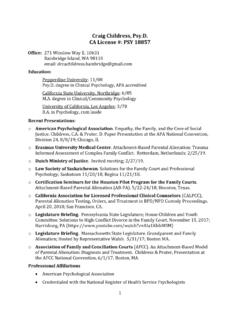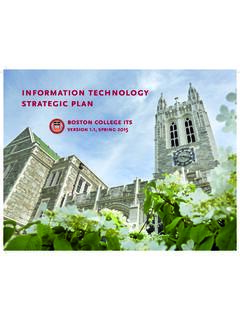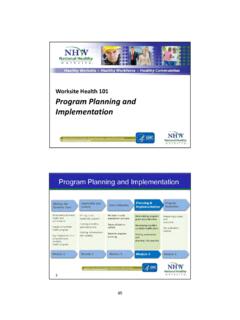Transcription of Making cities smart and sustainable
1 Making cities smart and : Why smart and sustainable p4/ smart sustainable city: Getting there p10/References p142 PwCPreface Sustainability is about ecology, economy and equity. Ralph BickneseOur planet, inhabited by over 7 billion people, is in the midst of a massive transition in terms of the ecosystem, climate change, tectonic plate movements and biological evolution. Among these, climate change, largely attributable to human activities, is one of the most critical issues impacting our planet. Climate change brings with it adverse consequences such as threats to biodiversity and ecosystems, risks to human health, rising sea levels due to accelerated melting of glaciers and ice caps, increasing water stress as well as a decline in agricultural productivity. These issues are driving many worldwide economies and cities to focus on mitigating greenhouse emissions in order to combat the impact of climate change. cities account for the majority of greenhouse gas emissions and energy consumption across the globe.
2 As cities are economic growth drivers in most of the nations, urbanisation is projected to increase further in the near future. This, in turn, will drive the depletion of non-renewable resources as well as add to the extent of carbon dioxide emissions. To cope with rising urbanisation and climate change issues, innovation and digital technology must be leveraged to minimise energy consumption and improve quality of life. Innovation must be combined with energy, digital technology and information and communications technology to address urbanisation challenges and ensure sustainability. Sustainability covers not just the environmental aspect but also social equity and the economy. The globe is witnessing a shift in economic corridors of power, as China and India are seen as the most powerful economies to watch out for. These emerging economies too need to take pre-emptive steps so as to avoid the devastating consequences of climate Indian government has undertaken concrete steps for Making smart cities a reality with the recent announcement of 98 aspirants.
3 These smart cities will compete with each other to come up with holistic plans for becoming model cities . The government has incorporated sustainability as one of the key components of smart cities . With the increasing frequency of natural disasters, abnormal weather patterns and the looming threat of global warming, the concept of a smart city must be merged with sustainability for the welfare of people and our planet as a whole. The marriage of innovation with technology will go a long way in optimising the management of infrastructure and resources and, at the same time, focussing on inclusiveness and a greener environment. smart sustainable cities will lay the foundations for a better future a future where cities care for people, the earth, air, water and the knowledge paper has been prepared for a seminar organised by the Information Exchange Group s summit smart City Landscape 2015 , to be held in New Delhi on 10 and 11 September 2015 . The paper is intended to stimulate discussion on the possible avenues for merging the concept of sustainability with the smart city framework to improve the quality of life for city inhabitants.
4 It will also enable decision-makers to take cognisance of the existing situation, study the best global practices and explore avenues for incorporating them into their city mission and RatanLeader, Government and Public SectorPwC IndiaSmart sustainable cities4 PwCMaking cities smart and sustainable 5 cities : Why smart and sustainable Citizens: True,/The people are the city. William Shakespeare, Coriolanus, Act 3, Scene 1 cities are indispensable to nations they are hubs of economic growth and innovation and are cultural melting pots. They usually have unique characteristics and a cultural identity as well as present a multitude of options for business, employment, leisure, entertainment, healthcare and education. Given these attributes, cities attract people from rural regions seeking opportunities for employment, education and a better lifestyle. Hence, cities have been witnessing the megatrends of population explosion, a growing middle-class population and urbanisation.
5 By the year 2050, approximately 70%of the global population is projected to live in cities . Moreover, Asia, Africa and other emerging economies will be home to nearly 80% of global urban population in the near. India, too, is experiencing these trends, with an exponential growth in urban population owing to the promise of more employment and entrepreneurial opportunities and good quality of population (% of total)Name of country : India20112012201320143233341. UN World Economic and Social Survey 2013 UN World Economic and Social Survey 2013As per the data from Census 2011, the population living in urban regions contributes 63% of the country s GDP. This share is only expected to increase further as more and more people migrate to urban areas. By the year 2030, cities are forecast to have 40% of the country s population and account for 75% of the country s GDP. Thus, cities are likely to continue being the powerhouses and talent warehouses Wof India.
6 Apart from advantages, urbanisation also brings with it certain challenges. Many Indian cities are plagued with various environmental, social and economic issues such as resource scarcity, congestion, pollution, poverty, lack of affordable housing, proliferation of informal dwelling, as well as sewerage and sanitation problems. In fact, urbanisation is placing an environmental load on natural resources as cities account for 60 80% of energy consumption across the globe and for more than 70% of worldwide carbon dioxide emissions. In order to provide better living conditions for existing and future generations, cities need to be improved by adopting the smart route and at the same time focussing on the sustainability aspect. Currently, urban infrastructure is mostly developed without giving much consideration to sustainability. Looking at urban development through the sustainability lens paves way for the concept of sustainable cities . According to the World Bank s sustainable cities Framework: sustainable cities (SC) can be understood as resilient cities that can more readily adapt to, mitigate, and promote economic, social, and environmental change.
7 sustainable development encompasses all aspects of a city s healthy development and should be done with a triple bottom-line in mind - addressing economic/financial, social, and environmental issues. At the same time, ICT and its applications have played a transformational role in solving complex problems around the world. The potential to use ICT-enabled solutions for helping cities deliver innovative and improved services to citizens led to the concept of smart cities . Over the years, there have been many definitions of a smart city and each of these has had varied linkages with sustainability. But the recent conceptualisations of a smart city, including the Indian government s smart city guidelines, do accord due importance to sustainability principles. PwC s smart city concept states that: smart cities leverage technology and utilise existing and planned infrastructure investments to provide a higher quality of living to residents, a conducive investment climate for businesses and allow maximisation of resource utilisation and transparency for governments.
8 They can be considered for organic integration of systems, IT infrastructure, physical infrastructure, social and business infrastructure. These systems work collectively so as to generate intelligent and actionable information for decision-makers. From the above two definitions, it is evident that the two concepts share a common vision. Also, ICT can play a significant role in realising the vision of a sustainable city, and any city that runs on a robust ICT-enabled infrastructure and service delivery model needs to be sustainable as well. Therefore, it is only natural to expect the convergence of these two concepts into something that leverages ICT as well as places the sustainability lens over urban development and planning. That is, a city needs to be both sustainable and smart . According to the International Telecommunication Union Telecommunication Standardization 6 PwCMaking cities smart and sustainable 7 Sector (ITU-T) Focus Group on smart sustainable cities (FG-SSC): A smart sustainable city is an innovative city that uses information and communication technologies (ICTs) and other means to improve quality of life, efficiency of urban operation and services, and competitiveness, while ensuring that it meets the needs of present and future generations with respect to economic, social and environmental aspects.
9 Sustainability calls for economic also calls for inclusive stakeholder engagement, robust governance, accountability and continuous monitoring, and transparent reporting. Successfully embedding these tenets of sustainability into smart city plans will require clear articulation of the role of ICT in achieving the city s vision, urban development benchmarks, responding to the needs of citizens and other stakeholders, and supporting the required governance structure. According to the ITU-T FG-SSC s master plan for smart sustainable cities , there can be no single approach for Making a city both smart and more sustainable . Each city is unique, with a unique economic, environmental and social context, and will have to determine a unique path to becoming smart and sustainable . Economic progress- Competitive economy- Employment growth and opportunity- Affordable housing- GovernanceSmart city componentsSustainable city components Institutional infrastructure- E-governance and citizen services 5.
10 How smart are our cities , PwC and Express Technology Sabha Report 6. The International Telecommunication Union (ITU) is the United Nations agency specialising in the field of ICTs. Physical infrastructure Environmental stewardship- smart energy management- smart water management- smart waste management- Urban mobility - smart communications- smart environment - smart spaces - smart surveillance - Climate change mitigation and adaptation- Water, waste and energy management- Green buildings- sustainable transport- Water quality and air quality- Natural resource management, including biodiversity and green cover- Incubators, skill development centres, specialised business parks, hubs, etc. Economic infrastructure Social infrastructure Social development- smart healthcare - smart education - Recreation: arts, sports, entertainment- Social inclusion, stakeholder engagement and participation- Human rights- Sanitation, public health and safety8 PwCMaking cities smart and sustainable 9 smart citySustainable citySmart sustainable cityEmployment growth and opportunityCompetitive economyIncubators, skill development centres, specialised business parks, hubs, sustained, inclusive and sustainable economic growth, full and productive employment, and decent work for allIncubators, skill development centres, specialised business parks, hubs, growth and opportunitySocial inclusion, stakeholder engagement and participationReduce inequality within and among countriesSustainable transportGreen buildingsSmart spaces smart communicationsClimate change mitigation and adaptationBuild resilient infrastructure, promote inclusive and sustainable industrialisation, and foster innovationHuman rightsSocial inclusion.















